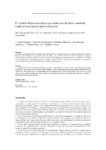El modelo biopsicosocial en los síndromes de dolor vertebral: implicaciones para la protocolización

Use este enlace para citar
http://hdl.handle.net/2183/16071Coleccións
- GI-IPRF - Artigos [150]
Metadatos
Mostrar o rexistro completo do ítemTítulo
El modelo biopsicosocial en los síndromes de dolor vertebral: implicaciones para la protocolizaciónTítulo(s) alternativo(s)
Model biopsychicalsocial in the syndromes of vertebral pain: implications for the protocolizeAutor(es)
Data
2001Cita bibliográfica
Valera Garrido F, Martínez Rodríguez A, Medina Mirapeix F, et al. El modelo biopsicosocial en los síndromes de dolor vertebral: implicaciones para la protocolización. Rev Iberoam Fisioter Kinesiol. 2001;4(2):81-87
Resumo
[Resumen] De forma tradicional el modelo biomédico ha predominado en la práctica asistencial. A diferencia de éste, el modelo biopsicosocial considera a la persona como un todo y hace énfasis sobre la función en lugar de centrarse exclusivamente en el alivio del dolor. En este sentido, la Fisioterapia para el tratamiento de los problemas de espalda, y en concreto para la cervicalgia, tiene que considerar, además del alivio del dolor, la cronicidad y la recurrencia como elementos a considerar en el diseño de actividades protocolizadas. [Abstract] In a traditional way the biomedical model has prevailed in the health care. Against it the biopsychicalsocial pattern considers to the person as a whole and it makes emphasis on the function instead of being centered exclusively in the relief of the pain. In this sense, Physiotheraphy for the treatment of the back problems and in this case for the neck pain, it has to consider besides the relief of the pain, the chronic and the new episodies like elements to consider in the design of protocolized activities.
Palabras chave
Biopsicosocial
Dolor vertebral
Biopsychosocial
Vertebral pain
Dolor vertebral
Biopsychosocial
Vertebral pain
Versión do editor
Dereitos
Creative Commons Licence Reconocimiento-NoComercial-SinObraDerivada 4.0 Internacional






